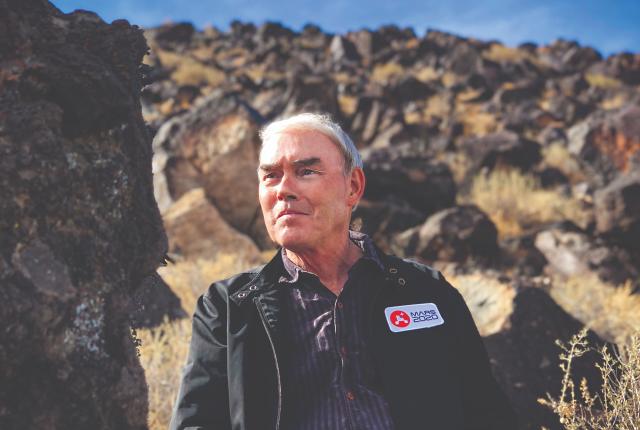VOLCANOLOGIST LARRY CRUMPLER has long studied New Mexico’s lava-filled past while working at the New Mexico Museum of Natural History & Science, in Albuquerque. Over the last 15 years, his research has stretched to outer space, thanks to his role as a long-term planning lead for NASA’s Mars Exploration Rover project, including its newest craft, Perseverance. A small hill near a mountain on Mars was even named for him: Larry’s Lookout. He revisits those adventures and passionately dives into scientific concepts in a new book, Missions to Mars (HarperCollins). Raised in North Carolina, Crumpler chose to live in New Mexico partly because of our geology’s visibility and accessibility. He and his wife, geologist Jayne Aubele, live just outside the southern end of Petroglyph National Monument, near one of their favorite geologic landscapes.
As a kid, I was interested in exploration—the Arctic, Antarctica, all that. I was standing by the radio in 1965 when the Mariner 4 flew by Mars, and I saw headlines the next day saying that Mars was an old, dead planet.
But in the 1970s, they started seeing evidence of volcanoes and rivers on Mars. It became obvious to me that geology and geographic exploration were one and the same.
Mars has always been a mystery for a lot of people.
Back then, we all wondered what those strange blotches and streaks were on it. The funny thing is that those had nothing to do with the surface. It was the wind blowing, or whatever. The underlying geology was more fascinating and layered.
To me, Mars is like the coyote legend. It’s a trickster. Every time we think we’re figuring something out, we learn that we were totally wrong.
A friend at Acoma Pueblo said it’s like his vision of a grandfatherly figure who causes the grandchildren problems to teach them something.
I wanted to title the book Coyote Moon, but my publisher wouldn’t go for it.
Right now, I’m summarizing Perseverance’s first 360 days. It’s in a crater with this big river delta and lava flows. We want to get a handle on all that before it traverses the crater to the delta and some outcrops.
It’s kind of like having a busload of experts driving across the landscape and stopping to explain things.
I can’t separate Mars and New Mexico in my mind. There’s a quality to the landscape on Mars that’s very similar to New Mexico. And the lighting on Mars is like a late afternoon in the fall in New Mexico.
If you were on Mars, you’d realize it’s all about the light.
I was never a fan of Star Trek or Star Wars. I was from the era of Forbidden Planet, Robby the Robot, and all that.
One of my favorite places to see geology here is the Río Puerco Valley. You’ve got all the elements—the sediments from the inland sea 70 million years ago, the volcanic necks from the Mount Taylor volcanic field—and you can get right up and see them. It’s mind-boggling.
You have the Valles Caldera just up the road. It’s the best example of a caldera from a supervolcano.
We studied lava flows in Idaho and Hawaii and kept coming back to the McCartys lava flow, near Grants. Its youngest part is right on NM 117.
I like to say that being in New Mexico and not knowing geology must be like living in a library and not knowing how to read.
Purchase Larry Crumpler’s Missions to Mars or hear one of his talks on YouTube.


